NORTH WALES COAST RAILWAY:NOTICE BOARD
Rheilffordd arfordir gogledd Cymru: Hysbysfwrdd
23 January 2017
Share on Twitter
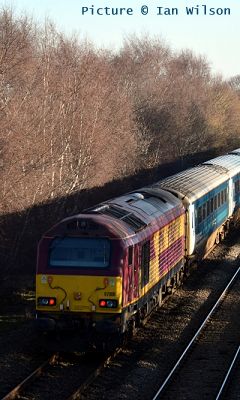
Tweets by @NWrail1
Contributions and comments are encouraged: see the Contributions Page
This list may be out of date if you are reading an archived issue. For full information visit our Calendar page.
January 2017
Friday 27 January Great Western Society North West Branch. North of Preston - Barrie Rushton
February 2017
Wednesday 1 February RCTS Liverpool Mark Youdan. North West Railway Photography, 1995-2015. Mark, a Branch member, is a Driver/Trainer for Arriva Rail North and held the same position with Northern Trains.
Friday 3 February Clwyd Railway Circle BR Steam - The Splendid Years (1959-65 in B&W) Steam around the regions in the early 60’s by John Sloane.
Tuesday 7 February North Wales Railway Circle Birkenhead to The Coast. North Wales Railway Circle life member Ken Owen entertains us with a selection of pictures starting in Birkenhead, visiting his home town of Wrexham and travelling via his present home Redhill to Eastbourne and Margate on the South Coast.
Wednesday 8 February Welsh Highland Railway North Wales Group Gareth Haulfryn Williams - The Vale of Rheidol Railway.
Thursday 9 February Llandudno & Conwy Valley Railway Society Snowdon Mountain Railway, by Mike Robertshaw
Friday 10 February Altrincham Electric Railway Preservation Society Lecture The Splendid Years of BR Steam 1959-1963. A digital presentation by John Sloane
Monday 20 February RCTS Chester Fred Kirk: Leicester Area Steam Days. Fred, from Leicester, spent a lot of his time bicycling around with his camera at the ready to various locations on all the main lines within reasonable reach of his home.
Friday 24 February Great Western Society North West Branch. Group AGM
March 2017
Friday 3 March Clwyd Railway Circle Amlwch Branch Line and Annual General Meeting Chairman of the Lein Amlwch - Central Anglesey Railway Company, Walter Glyn Davies will give a presentation on the progress of the lines revival. The talk will be followed by the Annual General Meeting.
Tuesday 7 March North Wales Railway Circle The Abergele Accident. Tony Griffiths gives a talk on the accident that occurred on 20th August 1868 at Abergele involving the Irish Mail and a part of a goods train that was being shunted.
Wednesday 8 March Welsh Highland Railway North Wales Group Speaker to be confirmed
Thursday 9 March Llandudno & Conwy Valley Railway Society ... And we run trains too! Clare Britton (Ffestiniog Railway)
Friday 10 March Altrincham Electric Railway Preservation Society Lecture Eric Lomax, Railwayman of War and Peace. Images of steam in the UK before and after the Second World War with a few taken in India during the war; featured locos are a mixture of industrial and main line, mostly in Scotland A digital presentation of black and white images by Dr Michael Bailey
Monday 20 March RCTS Chester Paul Chancellor. A Colour-Rail Presentation. Paul, from Bromsgrove, is owner of Colour-Rail and will highlight the work of many fine railway photographers covering the better part of 70 years. He is also the RO Editor for the ‘Preservation and Other Railways’ section.
Friday 31 March Great Western Society North West Branch. Birkenhead Joint Railway. Paul Wright.
April 2017
Tuesday 4 April North Wales Railway Circle Bangor to Hong Kong by Rail. Adam Fetherstonhaugh gives an account of his epic journey by rail from Bangor to Hong Kong via Beijing and then on to Vietnam and Cambodia.
Friday 7 April Clwyd Railway Circle Railways of North Cheshire in Early BR Days Being a Manchester lad, Russell Hatt was able to capture the busy scenes around his home area.
Friday 7 April (note: first Friday of the month) Altrincham Electric Railway Preservation Society Lecture The Last Years of British Trolleybuses A colour slide presentation by Brian Yates
Wednesday 12 April Welsh Highland Railway North Wales Group Norman Kneale, Renowned railway photographer.
Thursday 13 April Llandudno & Conwy Valley Railway Society Barry Wynne's Steam Odyssey.
Monday 24 April RCTS Chester George Jones : Onwards to Corwen.George lives in Wrexham and for many years has been an important publicist for the Llangollen Railway and certain of its locomotives. He will cover the railway’s reinvigoration of the line to Corwen and look at its future prospects.
Friday 28 April Great Western Society North West Branch. The L&Y in BR days. Noel Coates.
May 2017
Tuesday 2 May North Wales Railway Circle AGM and Annual Photographic Competition. The Annual General Meeting of The North Wales Railway Circle will be followed by the annual photographic competition. Members are invited to submit their work in three categories, prints, slides and video. Video to be kept reasonably short, approx. 5 mins. In line with Circle rules all work should have been taken in the last 12 months.
Wednesday 10 May Welsh Highland Railway North Wales Group Group’s AGM + John Ellis Williams - The Continuing Story.
Thursday 11 May Llandudno & Conwy Valley Railway Society A tribute to the late David Jones, by John Myers
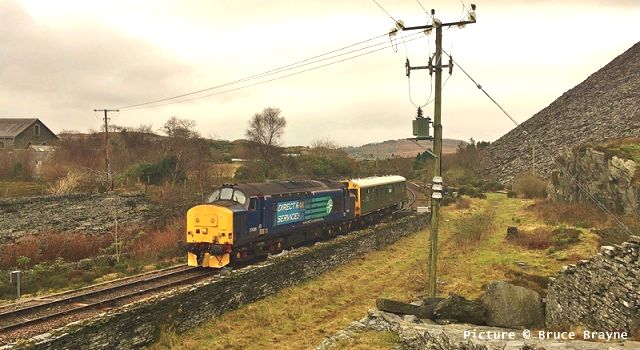
37 405 arrives at Blaenau Ffestiniog with inspection saloon 'Caroline', 18 January. Picture by Bruce Brayne. (More on Caroline next issue)
Class 60 on the Coast
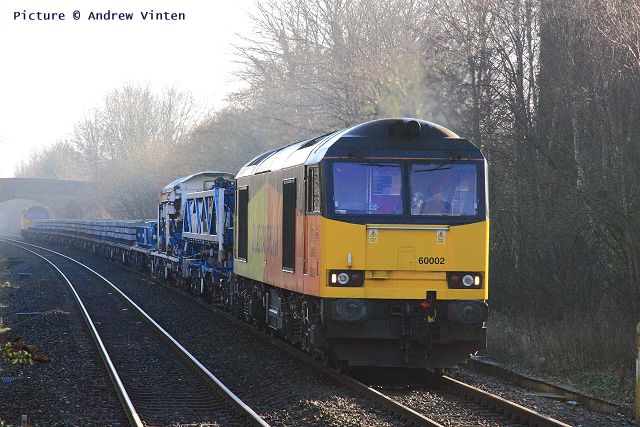
An interesting movement on 20 January was the with 6Z56 New Track Construction Train from Crewe Basford Hall to Rhyl, hauled by 60 002. Andrew Vinten's picture above shows the whole train: the gantry seen behind the loco is designed to travel along rails on the sides of the other wagons, picking up a section of track and lowering it into place.
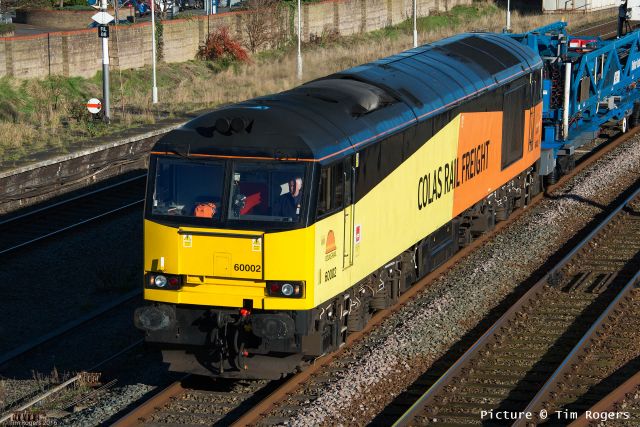
A pretty momentous occasion for 'Tug Chasers' was the appearance of Colas 60 002 at Rhyl. , top-and-tail with ...
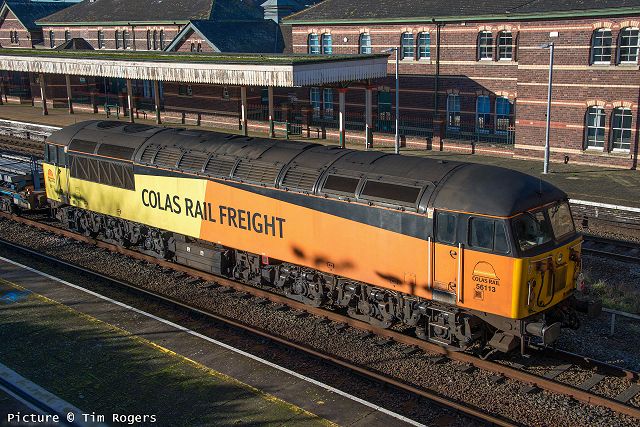
... 56 113. The train arrived at Rhyl at lunchtime and stabled in the centre road (above). Pictures by Tim Rogers.
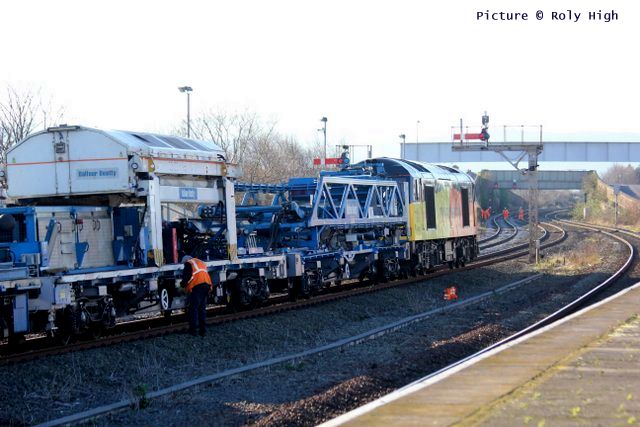
A look at the active wagons (Roly High).
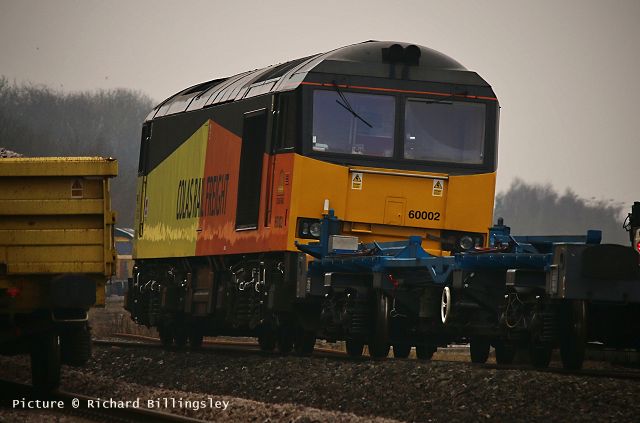
The train travelled to the work site at Mostyn on Saturday 21st. (Richard Billingsley)
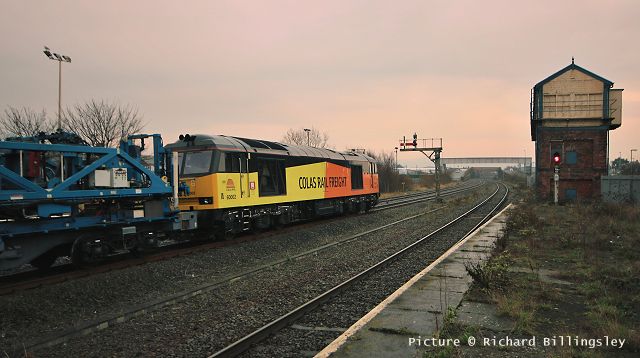
Back at Rhyl on Sunday 22nd, t was stabled again in the centre road (above) to await its return to Crewe early on Monday morning. Richard Billingsley writes: 'It's good to see a 60 back down here, I'm pretty sure the last visit of the class was back in 2007.'
On the subject of Colas Rail, US reader Andrew Easom writes: 'On 23 January I noticed a Colas Rail class 70 loco in Norfolk Southern's Rockport Yard near Cleveland, Ohio.'
Changes at Rhyl and Abergele - pictures by Roly High
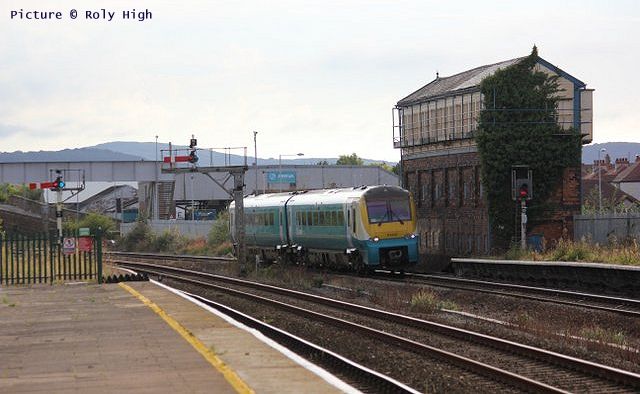
Two views at Rhyl station. Above, September 2015, with the Arriva bus garage and the disused Rhyl No.2 signalbox vanishing under ivy.
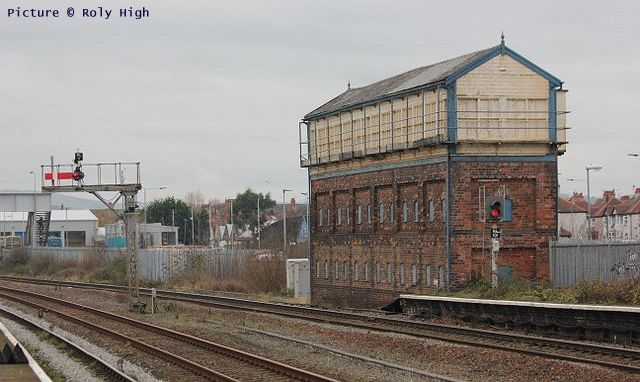
January 2017: the bus garage has been demolished and replaced by a new one further away. The signalbox has been cleaned up, but it is still a listed building looking for some sort of purpose; if Network Rail's plans come to fruition, No.1 signalbox at the other end of the station, now just 'Rhyl' will also become redundant. What future can these specialised buildings have?
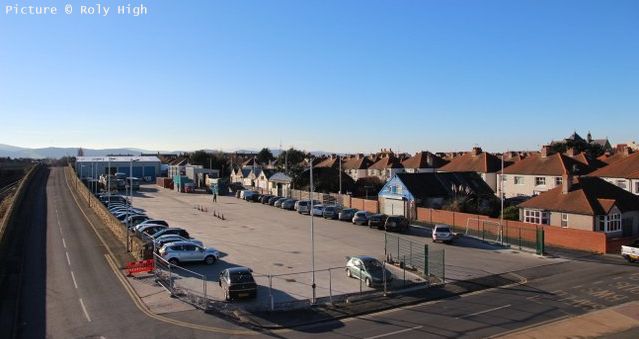
The old garage site being used as a staff car park.
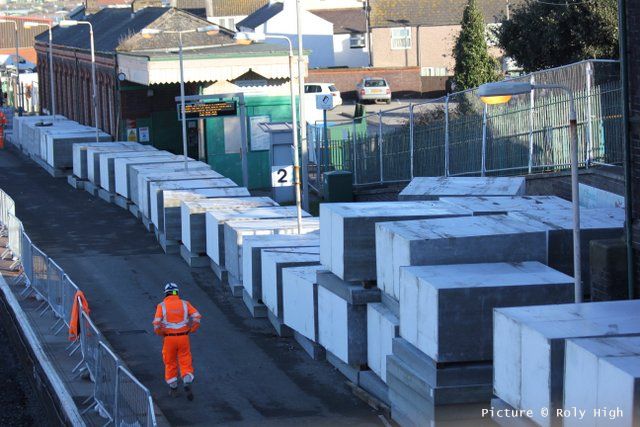
These polymer blocks lined up at Abergele will form the basis of the widened platform.
Ultrasonic on the top line - pictures by Tim Rogers
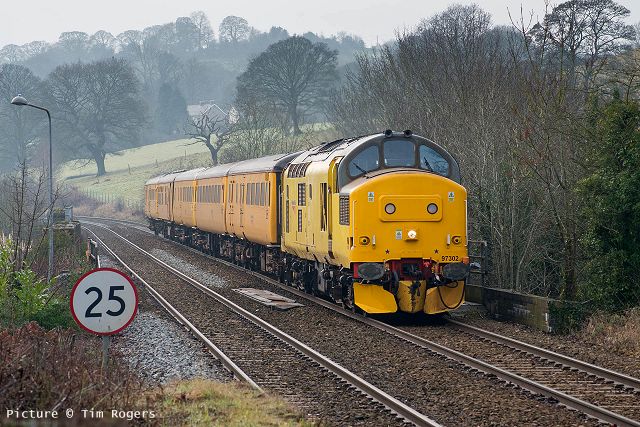
Tim Rogers was at Cefn-y-Bedd on 17 January to record the Ultrasonic Test Train, 3Q15 09:48 Shrewsbury Abbey Foregate to Shrewsbury Abbey Foregate via Bidston, powered by 97 302.
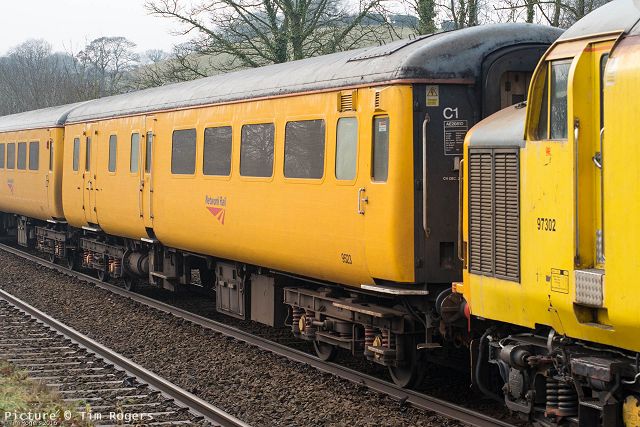
Mk2f BSO, Network Rail brake force runner 9523.
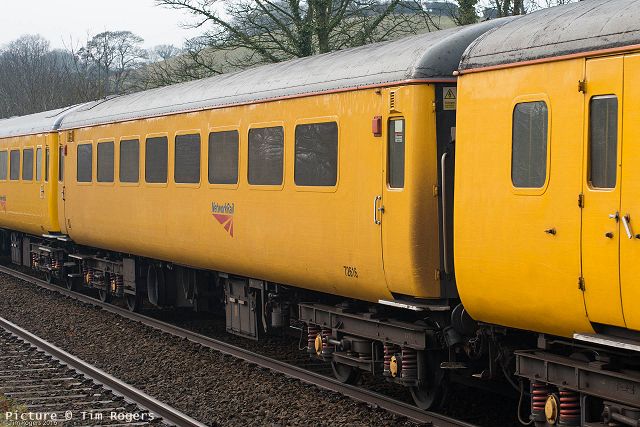
Mk2f Brake Force Runner 72616; its number series reveals that it was once a Gatwick Express vehicle.
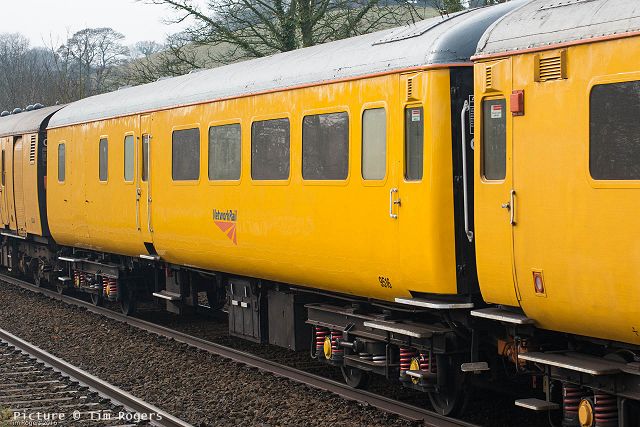
Mk2f BSO, Network Rail brake force runner 9516. These 'brake force runners' are needed as Network Rail rules impose speed restrictions on very short loco-hauled trains, the extra wheels allow more effective braking when required.
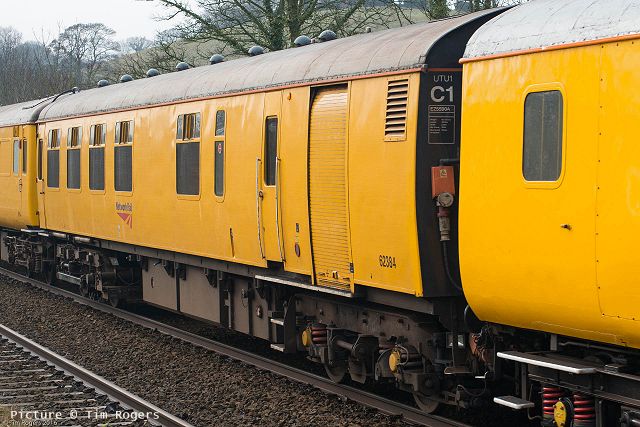
Ultrasonic Test Train coach (UTU1) 62384, formerly the motor coach of a Southern Region 4-CIG electric unit, chosen for the heavy-duty bogies fitted to these vehicles.
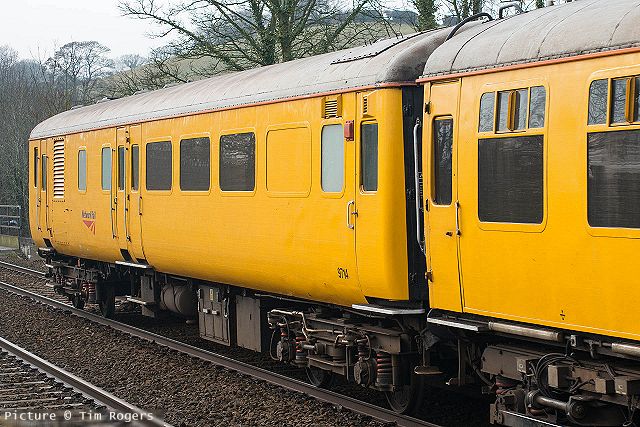
Mk2f, DBSO 9714. The grille behind the cab is for cooling the diesel generator which is fitted to this vehicle.
67 008 in action
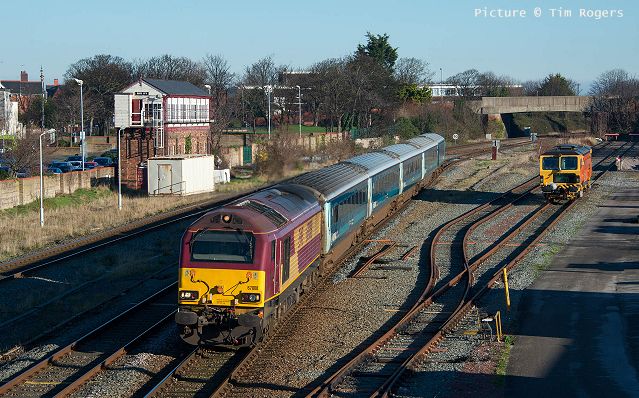
On 20 January 67 008 brings 1D34 09:50 Manchester Piccadilly to Holyhead into Rhyl on 20 January. In the siding is 08-164X4C-RT tamper DR73912 Lynx (Tim Rogers).
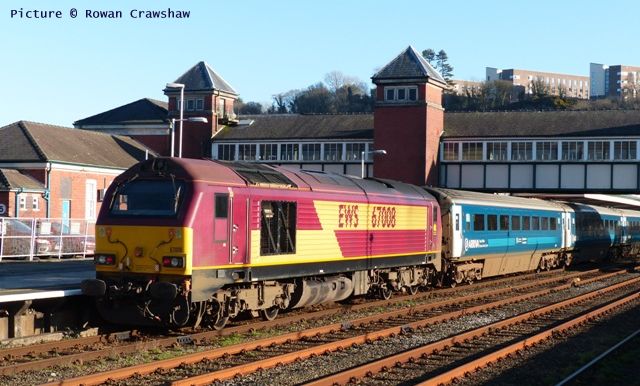
The return train on 20 January, 13:07 Holyhead - Manchester, calls at Bangor with 67 008 propelling (Rowan Crawshaw).
Disaster at Chester, 1972
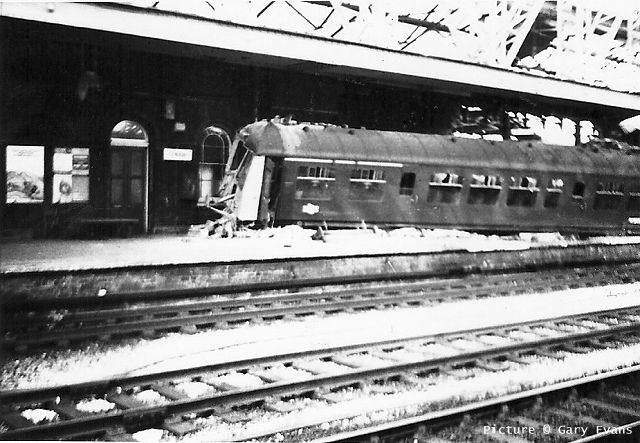
The evening of 8 May 1972 was a disastrous one for Chester station, as these pictures, taken on the following day by the late Gary Evans, testify. Our thanks to Mr Evans' nephew, Paul Roberts, who writes: 'These pictures, and a collection of press cuttings, were passed on to me several years ago after his death, and I’ve just rediscovered the scans I made.' We have prepared some notes on the accident to accompany the pictures.
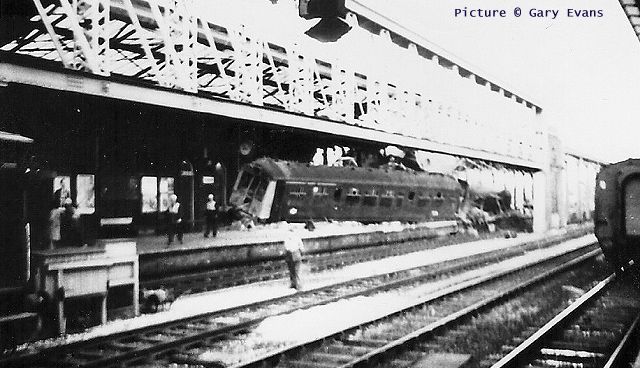
Freight train 8D66, 19.31 Ellesmere Port East Yard to Mold Junction marshalling yard, consisted of 38 vehicles, including a number of tank wagons loaded with petroleum products, hauled by Class 24 loco 5028. Most of the wagons were not fitted with vacuum brakes that could be controlled by the loco driver; some (including tank wagons from Stanlow refinery) that were so fitted were marshalled next to the brake van at the rear of the train on departure from Ellesmere Port so that their brake pipes could be connected to the loco when the train reversed at Helsby. However, the brake pipes had not been connected, and the train as it left Helsby was still running un-braked except for the brakes of the loco and the guard's handbrake at the other end of the train. On the 1 in 100 downward gradient towards Chester station the driver lost control of the train which passed signals at danger, running into Chester station at an estimated 20 mph.
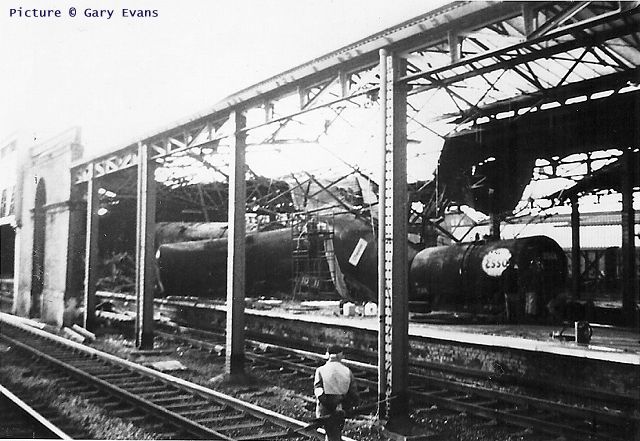
At the station, a shunting move had been progress involving moving an empty DMU into bay Platform 11 (today's platform 5) and the points were set for this movement and were locked due to the runaway train occupying track circuits, so the freight train collided with the DMU (Class 108 unit M56229 + M50946) and pushed it through the buffers on to the platform, wrecking the canopy above and damaging the wall of the refreshment room in the process. The driver, and a colleague who was travelling with him, managed to jump to safety on the platform just before the collision. A fire resulted, fuelled by the contents of the fuel in the tanks of the loco and the DMU; the barrels of the tank wagons which piled up behind the crushed brake van were not breached, but contents leaked from damaged valves.
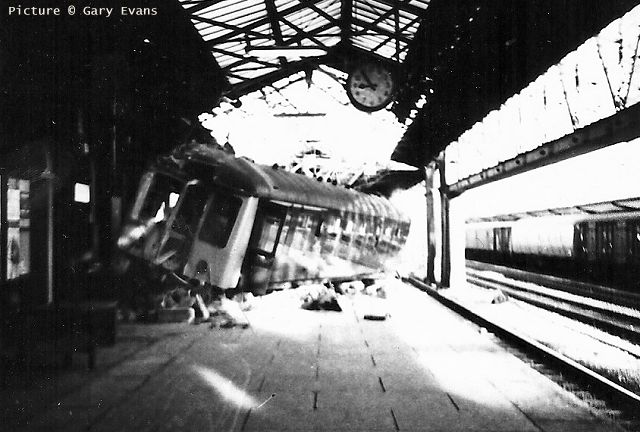
Luckily, a spare locomotive was on hand in the station, and the staff acted quickly to uncouple the the rest of the train from the three derailed wagons and move it clear of the fire. Even so, a serious fire ensued, also involving the Metro-Cammell DMU on the adjacent bay on the through platform (today's Platform 4) which was the 19:15 Bangor - Crewe, from which the passengers had been hastily evacuated. The fire brigade arrived and succeeded in bringing the fire under control by form over the burning fuel. The only serious injury was to a postal worker who was loading mail into the Crewe train. The station building was repaired, but the destroyed canopy over the space between the building and bay platforms 5 and 6 has never been rebuilt, to the annoyance of Mid-Cheshire line passengers on wet days.
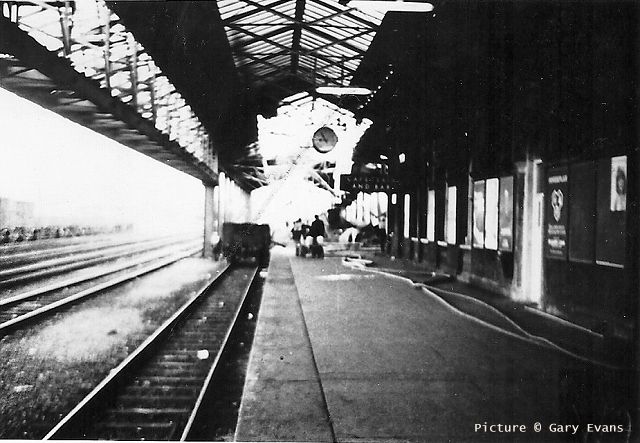
Loco 5038 was beyond repair and had to be scrapped, as were the two cars of the unit involved in the collision. Coaches caught up in the fire, M50407 and M51195 from the Crewe train, were completely gutted, as was trailer composite M56338 of the train standing in Platform 12.
At this time, the 'Hazchem' code now carried by all tankers was not applied to rail tankers, so the fire service staff did not know what the wagons contained. The only aid was that tankers for highly-inflammable liquids were painted grey with red solebars, although external cleaning of wagons was rarely scrupulous. This omission was remedied soon after this accident. Interestingly, behind the five Esso tanks in the train - one of Kerosene, one of petrol and three of Gas Oil (loco fuel for North Wales depots?) were three empty Associated Octel tanks, which would have been returning from the company's Ellesmere Port plant to their Amlwch site. The Octel plants are now history (well-told in a website by a former worker) and diesel fuel for trains at Chester and Holyhead travels by road.
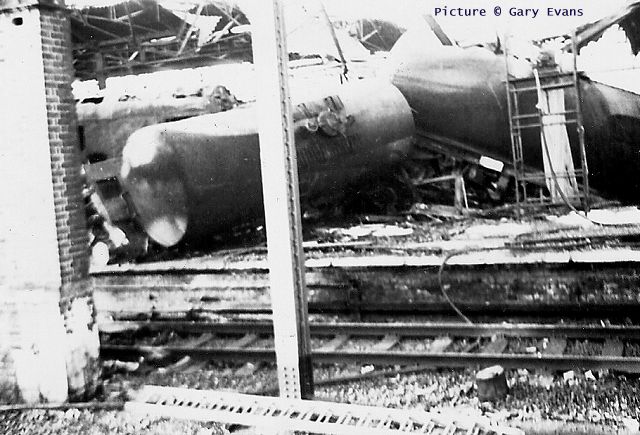
The final report on the accident (which can be downloaded from the marvellous Railways Archive website) placed the blame for the very expensive accident on the guard of the train who failed to connect the brake pipes, and the driver, who decided to proceed, even though he admitted he knew this had not been done. The station staff, on the other hand, were commended for their actions. Published accident reports in those days included great detail, and it was the practice to name all the rail staff involved, whereas today names are never mentioned, only roles.
In 2017 all trains have continuous air brakes in the control of the driver, and 'un-fitted' working is a thing of the past, as it largely was by 1972 in most other countries. Freight trains no longer have guards. Even so, any negligence in carrying out a brake test, perhaps combined with failure to open the air valves of a loco-hauled after coupling the pipes between loco and train, can create exactly the same situation as in 1972. The railway still depends on the vigilance of its workers.
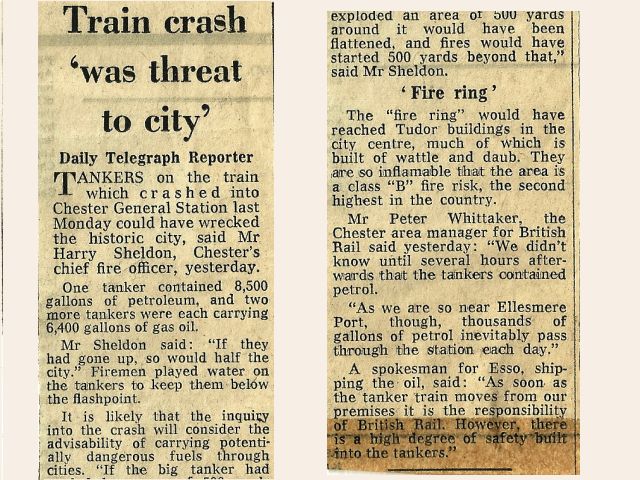
The report above is a little inaccurate; all the tank wagons were the same capacity. The statement by the BR Area Manager, if reported correctly, seems rather surprising.
A visit from Andromeda
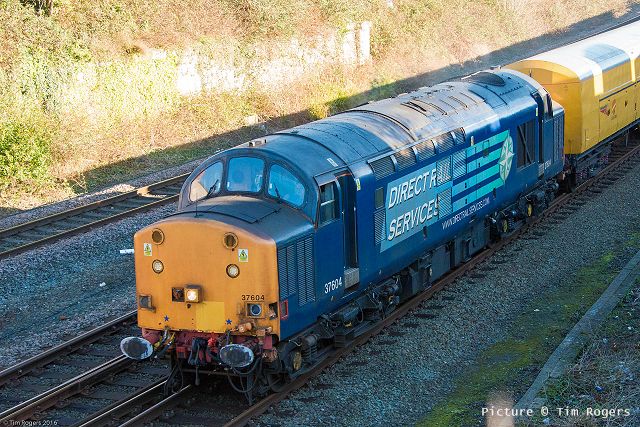
A track inspection ran train along the Coast on 20 January: 1Q50 07:35 Crewe T.M.D. (E) to Derby R.T.C.(Network Rail) via Blaenau Ffestiniog, Llandudno and Bangor. Tim Rogers photographed the train at Llandudno Junction westbound with 37 604 leading.
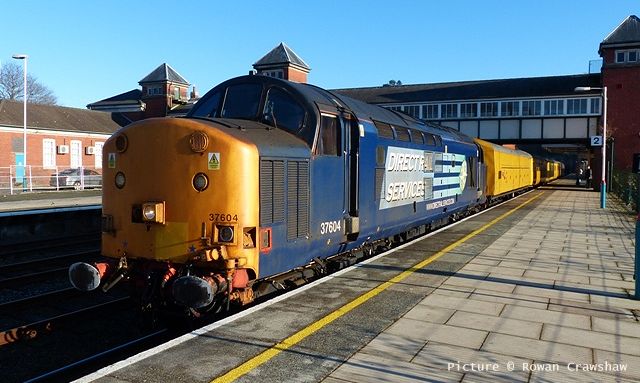
Bangor (Rowan Crawshaw). Behind the loco is one of the former parcels van modified in 1999 for a First Great Western 'Motorail' service which revived the idea of taking your car with you by train on the overnight train to the west, but only lasted a few years. Network Rail have taken on this one as a 'brake force runner'.
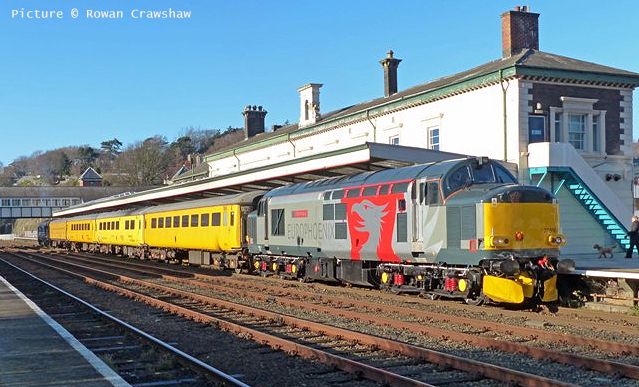
The return train at Bangor (Rowan Crawshaw). Making a surprise appearance, 37 608 Andromeda, sold last year by DRS to the Europhoenix company and recently given a repaint in their striking livery.
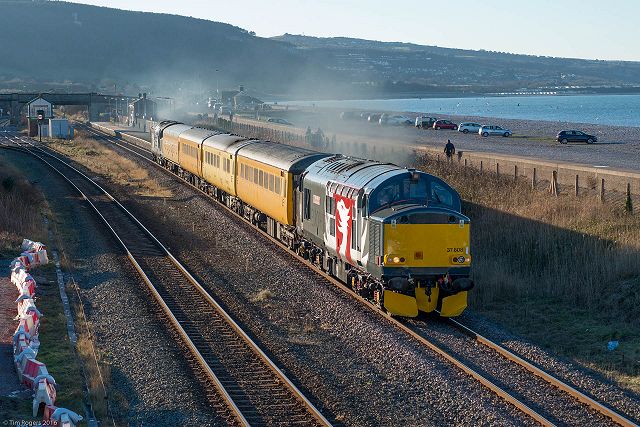
Abergele (Tim Rogers). The formation: Mk2f Radio Survey Train coach 72612; Mk2f Network Rail Track Inspection Coach 2 (TIC2) 977974; Mk2f Plain Line Pattern Recognition vehicle (PLPR4) 72639; Network Rail Brake Force Runner, Ex Mk1 Motorail van 96604.
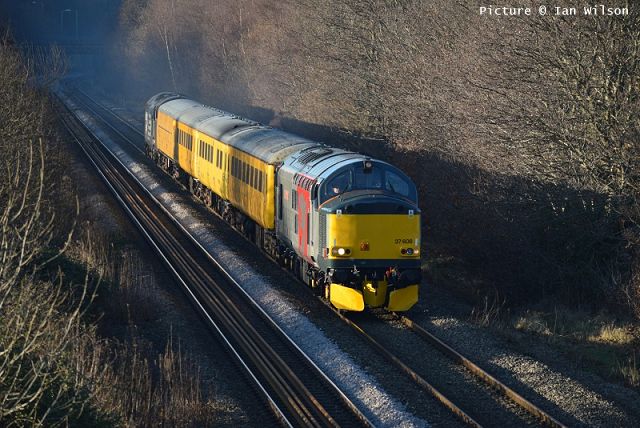
Mostyn (Ian Wilson)
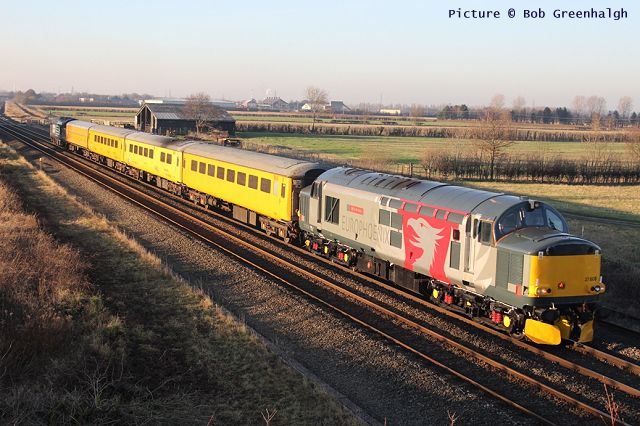
Beeches Farm (Bob Greenhalgh).
North Wales Coast home page | Archive | Previous Notice Board